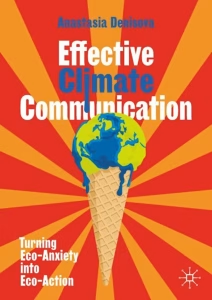By Anastasia Denisova, University of Westminster
Talking about climate change is never easy. The issue is complex and upsetting. Headlines bring bad news way more often than good ones.
Techniques based on the extensive analysis of theories and research from social psychology, sociology, environmental and media studies can pave the way for a consistent approach to climate action commitment and citizen empowerment.
Here are five ways to communicate climate stories in a way that keeps people engaged and motivated to take positive action.
1. Give people agency
According to the seminal research published in 1974 by the Canadian-American social psychologist Albert Bandura, humans are capable creatures who can overcome fears and lead happier, motivated lives when led correctly. He conducted a famous experiment with people who were afraid of snakes.

In one scenario, an assistant was holding a snake in their hands or keeping it in a cage, while the scared person was watching. In another scenario, the person was given a snake to hold, in a controlled environment, with the assistants eager to take the snake back at any signs of the person’s discomfort. Bandura discovered that looking at someone holding a glossy, hissy reptile did not improve one’s sense of empowerment much.
However, actually handling the scary creature allowed people to feel more in control – and more likely to overcome their fear. This approach is known for boosting people’s sense of agency. By tackling the problem with one modest action at a time, a person is likely to become more reassured in their capacity to challenge larger issues.
In terms of climate communication, we need to be able to control at least small bits of the situation in order to be psychologically equipped to tackle bigger challenges. Climate communicators can give practical suggestions on lifestyle amendments, feasible activism techniques, political involvement – to nourish the sense of empowerment in the audience.
2. Localize the issue
While researching for my new book, “Effective Climate Communication,” I discovered that many countries with fewer resources struggle to present local stories related to climate change. They tend to rely on the western agenda of UN climate summits or global reports.

The shortage of correspondents on the ground (see studies on Sub-Saharan Africa, Nigeria and South Africa, countries in South America and Asia), makes many media in the developing countries ignore the very local consequences of the global heating. When people are less prepared for extreme weather, they’ll be less empowered to demand change from their governments or invest in weather-resilient crops and other prevention techniques.
By capturing perspectives from the local businesses and scientists, people can talk more easily about the direct effects of climate change on the local environment.
For instance, Greenpeace Indonesia focused on three themes on their Instagram page: the imagery of floods and humans affected, the call to switch to renewable energy, and the argument against the “omnibus” bill, which allows coal companies renew their licenses easily every 10 years.
Connecting the local impact of climate change with the possible solution – reducing coal mining – brought a considerable number of clicks and comments to the stories. Although the link between Instagram and public opinion is hard to prove, the omnibus bill is still widely contested by Indonesian society.
3. Make stories relatable
Unless you’re called Elon Musk, Bill Gates (the co-founder of Microsoft) or Ursula von der Leyen (president of the European Commission), you don’t have a direct control over the management of climate change at a global level. Yet, it would be amazing to hear more stories of people who may be giving up long-haul flights, rejecting meat and divesting their pension from the fossil fuel funds. There are so many stories that can be told to inspire feelings of connection and hope.
According to classic “social proof” theory, if we can be sure that any new behaviour is the social norm, then we’ll be more eager to change. The moment people consider that refraining from eating meat, flying and buying unnecessary stuff are common patterns in their social circles, they will find it easier to follow suit, as shown by this study on the flying intentions of Germans, or research on the effect of social communities on pro-climate decisions in Europe.
4. Avoid ‘doomism’
Watching thrillers about the end of the world on the TV screen can be escapist and weirdly soothing. But witnessing the apocalypse unfold in front of us, through multiple news notifications and social media posts, is less gratifying. The narratives that compare climate change to the end of the humanity are supposed to incite action – but more often than not they lead to freeze or withdrawal reactions.
In some newsrooms, the practice of “the three Ds” flourishes in the face of the planetary problem – denial, delay-ism and dismissal. Doomist storytelling opens the doors for fake prophets and self-proclaimed superheroes who promise to fix the problem but end up in populism and scapegoating.
Avoiding doomism allows for “stubborn optimism,” a concept endorsed by Christiana Figueres, the ex-head of the UN climate change convention from 2010 to 2016. It is the dual approach of acknowledging the severity of the issue and the cost of the delays to action, but looking at the present state of affairs as an opportunity to avoid bigger damage and focus on the near-term solutions.
5. Create a new normal
Having a special climate change section within a media publication is a nice sign that the organization cares about the problem. But how likely are people to click on it just to discover another ambush of negative stories? Including climate references in the majority of stories, from fashion to travel, helps normalize climate change as a backdrop to all aspects of our lives.
There’s no need for preaching. Nobody wants to be patronized for their decision to take a flight to see the family that lives far away. But subtle travel listicles about local destinations, creative meat-free recipes or an imaginative reinvention of fashion advice as restyling, not buying, can offer up alternatives in creative ways.
It should not be a taboo topic at dinner parties or social events. Avoid “othering” the climate change issue and help people stay aware and committed to tackling the elements of it.
Being aware of climate change as a new norm is healthier than trying to push it away and deny it’s happening. Engagement with the biggest story of our time is the best catalyst for change that we have.
Anastasia Denisova is a senior lecturer in journalism at the University of Westminster.
This article is republished from The Conversation under a Creative Commons license. Read the original article. Banner photo: Two people having a conversation (iStock image).
Sign up for The Invading Sea newsletter by visiting here. To support The Invading Sea, click here to make a donation. If you are interested in submitting an opinion piece to The Invading Sea, email Editor Nathan Crabbe at nc*****@*au.edu.



